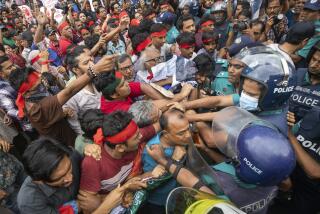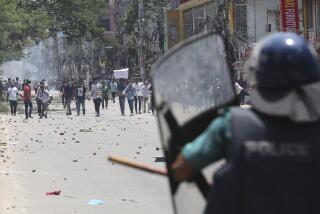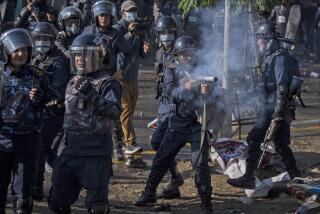300 Held for Anti-Chinese Rioting in Tibet Capital, Mayor Says
- Share via
BEIJING — More than 300 people suspected of taking part in anti-Chinese rioting have been arrested in Lhasa, the Tibetan capital, since the imposition of martial law there March 8, the city’s mayor said Friday.
“Some of them will be tried in public according to their crimes in the riots,” Mayor Logya, who uses only the one name, said at a press conference here at the Great Hall of the People.
Despite the martial-law crackdown against advocates of Tibetan independence, officials reiterated China’s desire to open negotiations with the Dalai Lama, traditionally the religious and political leader of Tibet, who has spent the past three decades in exile in India.
“We welcome the Dalai Lama to return to China so long as he renounces advocating the independence of Tibet,” Ngapoi Ngawang Jigme, an ethnic Tibetan who is a vice chairman of China’s National People’s Congress, said at the press conference.
The Dalai Lama had announced late last year that he intended to send a delegation to meet with Chinese officials in Geneva in January, but the meeting never took place.
Ngapoi said Friday that China refused to agree to the meeting because of three obstacles.
The first, he said, was that the delegation consisted of members of the “so-called Tibetan government in exile.” Beijing will not talk with representatives of this organization, he said.
The second was that the proposed delegation included a foreign legal adviser, and “we don’t allow any foreigners to be involved in the negotiations,” he said.
The third was that China wants to negotiate either directly with the Dalai Lama himself or with representatives who speak directly on his behalf, Ngapoi said.
The Dalai Lama, who after the imposition of martial law reiterated his interest in negotiations with Beijing, is the central figure in any possible relaxation of tension in Tibet. He is still adored by the vast majority of Tibetans, who have not lost their religious fervor despite 10 years of fierce suppression of religion during the 1966-1976 Cultural Revolution.
Tibet was part of the Chinese empire during the Qing Dynasty, but had de facto independence from 1911 to 1951. The Dalai Lama said last year that he could accept Chinese control over Tibet’s foreign affairs and defense if Beijing granted the region genuine democracy and self-rule.
The Dalai Lama’s most nationalistic supporters, especially monks in Lhasa-area temples, who still hope for complete independence, have over the past 18 months led repeated anti-Chinese demonstrations. On four occasions these pro-independence protests have erupted into rioting that the police suppressed by shooting into crowds.
Official Chinese reports said recently that, during this 18-month period, there were a total of 21 demonstrations or protests resulting in more than 600 casualties. No figure was given for deaths, but at least 31 people, and perhaps 100 or more, according to some estimates, have been killed in these incidents.
The March 5 rioting in Lhasa broke out after the police opened fire on pro-independence demonstrators who were throwing stones at a police station, according to Western tourists. Chinese officials have said that Tibetans used firearms against the police, and that only then did the police open fire.
More than 100 Western and Japanese tourists were in the city during the three days of rioting that ended with the imposition of martial law. Dozens of these tourists later talked with journalists, but there has been no report of a foreigner seeing a Tibetan with a gun.
Asked what evidence China has to show that Tibetans used firearms, Mayor Logya said that one policeman was killed and two were injured, and that this is “obvious evidence” that some rioters had guns. Logya said that “a small number of firearms have been confiscated and we are in the process of finding their sources.”
Tourists have said that a policeman using a video camera to film the rioting was beaten by a crowd and apparently killed when Tibetans hit him on the head with a large rock.
Sixteen people, almost all of them protesters or rioters, died in the three days of clashes last month, according to official Chinese statements. Western tourists and Tibetans have estimated that 20 to 50 people were killed.
Logya said that martial law will be only a temporary measure, and that after it is lifted, tourists will again be allowed to visit Lhasa.
“It is the basic policy of China to open to the outside world, and Tibet, including the city of Lhasa, is no exception,” he said. “As for how long martial law will last, it will be decided according to the development of the situation.”
More to Read
Sign up for Essential California
The most important California stories and recommendations in your inbox every morning.
You may occasionally receive promotional content from the Los Angeles Times.













